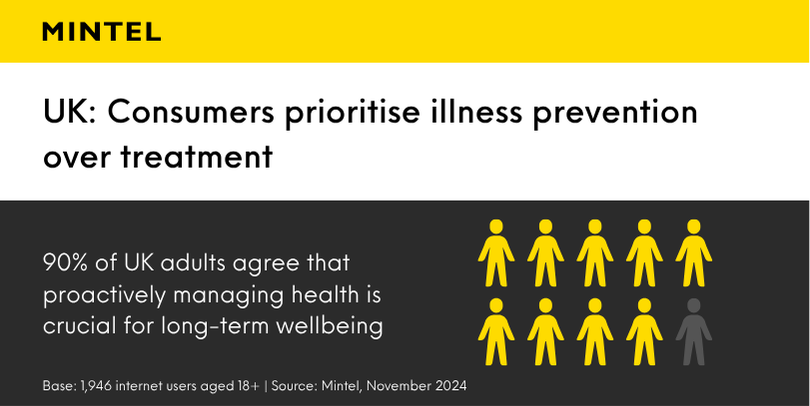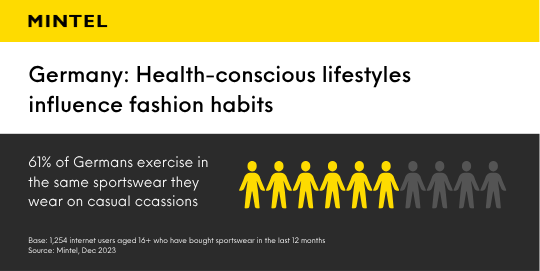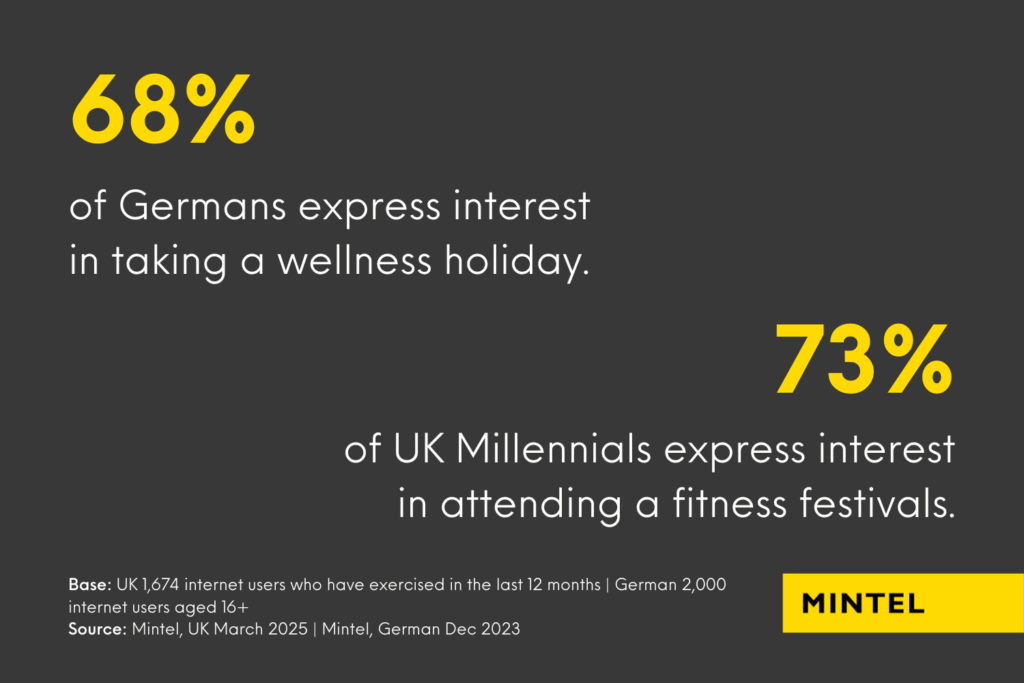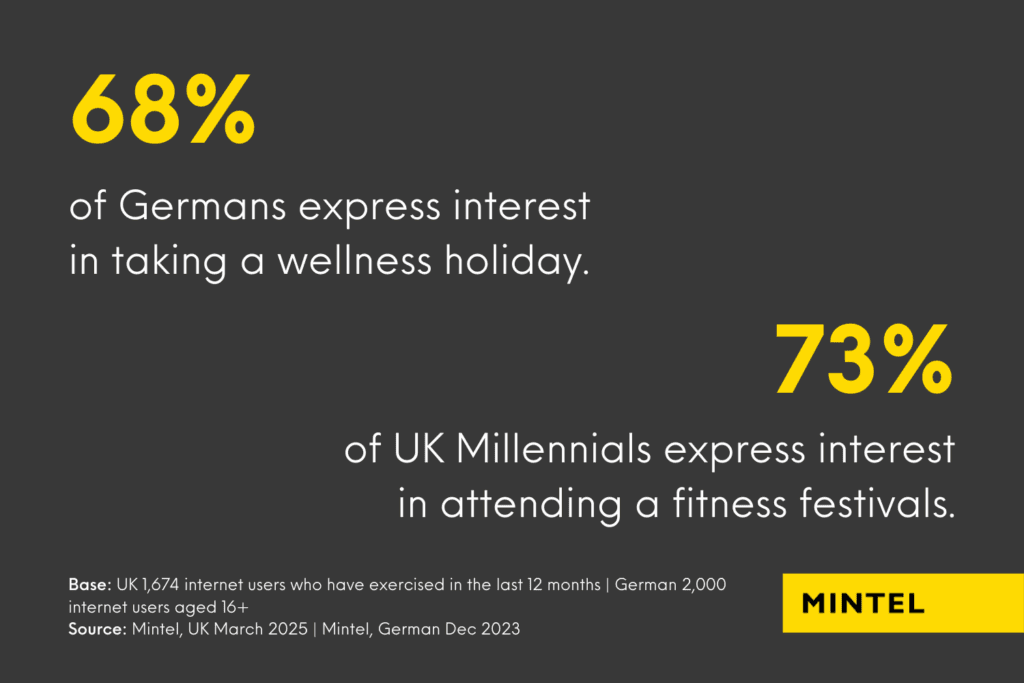Consumers worldwide are increasingly taking greater control over their health, marking a significant evolution in the consumer health market and self-care industries. This isn’t just a fleeting trend; the demand for preventive health care has grown stronger in recent years, significantly intensified by post-pandemic awareness of mental and physical wellbeing.
What is preventive health care?
Preventive care, at its core, involves taking proactive measures through lifestyle choices to maintain health and prevent illness before it occurs.
Gone are the days when health was solely about treating illnesses. Today, consumers are embracing a proactive approach. From wearable technology that monitors vital signs to functional foods designed to boost immunity, consumers are increasingly seeking products that help them maintain health, rather than simply treat illness. This transformation in mindset is reshaping not only the healthcare industry, but also tangentially influencing numerous other sectors, specifically consumer packaged goods (CPG), by effectively transforming consumer health concerns into purchase drivers.
In this article, we pair the findings of numerous health and wellness-focused research reports, which surveyed more than 10,000 consumers across the UK, US, Canada, China, and Germany, to examine the key drivers and trends that are shaping the consumer health market. We then pinpoint several industries, including fitness, food, wearables, and alcohol, that our research reveals are especially ripe areas for innovation and strategic brand partnership opportunities.
Consumer Health Market Size: How Large is the Preventive Health Care Market Opportunity?
Despite rising costs, the global health and wellness market has experienced steady growth since the COVID-19 pandemic, driven by a stronger prioritisation of longevity, preventive care, and holistic wellbeing. What’s more, is that it shows no signs of slowing down.
According to the Global Wellness Institute:
“The global wellness market was valued at approximately $4.4 trillion in 2022.
It is projected to reach nearly $8.5 trillion by 2027.”
Global Wellness Institute
Regionally, the health and wellness market is highly concentrated, with North America ($1.9 trillion), Asia-Pacific ($1.7 trillion), and Europe ($1.5 trillion) accounting for 90% of the demand.
This robust growth trajectory highlights immense opportunities for CPG brands ready to innovate and adapt, especially those making health easier to integrate into daily life or addressing multiple aspects of wellness.
What Are the Key Drivers in the Health and Wellness Market?
Drawing on Mintel’s market research and insights, here are the key factors driving the adoption of preventive health care approaches.
Proactive health management becomes mainstream
Across markets including the US, China, and India, consumers are increasingly priortising illness prevention over treatment. In the UK, 90% of adults agree that proactively managing health is crucial for long-term wellbeing, with 9 in 10 US women expressing a strong desire to take charge of their health.
A similar trend reveals itself in China, with 58% of consumers actively learning more about their health compared to the previous year. Meanwhile, in the US, over a third of consumers now use self-diagnostic tools to manage their health proactively, surpassing doctor recommendations as a primary motivator.

Economic value drives preventive health care investment
Economic uncertainties and rising healthcare costs have led consumers to view investment in preventative health as a long-term cost-saving strategy. In India, 8 in 10 consumers agree it is worth paying more for products that help prevent lifestyle diseases. This economic rationale of viewing healthcare spend as a savvy investment has spread globally, with consumers recognising that prevention often costs less than treatment, signifying a high-value opportunity for brands.
Health-conscious consumers lean into holistic wellbeing
There’s a growing understanding of the interconnectedness of physical and mental wellbeing. The definition of self-care has expanded to include mental, social, and emotional health. Consumers are seeking solutions that support overall wellbeing, including stress management, sleep hygiene, immune health, and social connection. For example, over 8 in 10 US consumers believe mental wellness is as important as physical wellness.
Technological advancements drive consumer health awareness
Digital tools like wearables and at-home diagnostics are transforming how consumers monitor and manage their health. Ownership of wearable devices is growing globally, revealing an increased reliance on technology for personal health tracking:
These digital health technologies are empowering consumers to take control of their health. By enabling personalised health care, individuals can monitor progress, tailor health decisions to their goals and lifestyles, and embrace preventive care more effectively. Looking ahead, digital tools and AI will continue to fuel the shift towards personalised health solutions.
The Power of Brand Partnerships: Opportunities and Trends Shaping the Consumer Health Market
The holistic, preventive health mindset breaks down traditional category barriers, creating numerous brand partnership opportunities across fitness, nutrition, clothing, technology, and wellness services.
Fitness and food synergy
Exercise and healthy eating go hand in hand. With over four-fifths of UK exercisers citing health as their main reason for working out, and they place just as much importance on healthy eating as they do on exercise, there is a strong connection between food and nutrition. This combination supports a more holistic approach to health, where nutritious food fuels performance and recovery, while exercise promotes physical and mental wellness. Food brands and gyms can tap into this synergy by offering integrated experiences that blend fitness with nutritional education.
Sportswear as a lifestyle statement
Sportswear demand is rising as health and wellness trends influence consumer habits, extending beyond exercise to everyday wear. In Germany, 6 in 10 sports goods shoppers wear sportswear casually. This shift offers brands the opportunity to create versatile, stylish options that align with active, health-conscious lifestyles.


Sober curiousity
Rising interest in health and wellness is driving consumers to moderate alcohol consumption, with many prioritising mental wellbeing, sleep, and overall health. Over half of US alcohol users agree that cutting back improves health, and 6 in 10 Gen Z and 50% of Millennials want more alcohol-free options.
This trend has opened doors for brands to innovate with low- and no-alcohol products, including non-alcoholic beers, wines, and spirits. Another approach is to add functional ingredients like vitamins, prebiotics, and adaptogens to cater to health-conscious consumers, just like the German brand Three Spirits. Their alcohol-free spirit, Social Elixir features adaptogenic ingredients like lion’s mane mushroom and yerba mate, added to mimic the relaxing effects of alcohol without the downsides, catering to consumers who are embracing mindful drinking.
Blending fitness with socialising
The preventive health care market offers a growing opportunity to merge fitness with social experiences. Millennials are particularly driving this trend, with 35% identifying health as a core part of their personal identity. Additionally, 7 in 10 Germans express interest in taking a wellness holiday in the future, and three-fifths of UK Millennials are keen on attending fitness festivals, highlighting the demand for events that combine wellness, community, and adventure.
One standout example is the UK-based Love Trails festival, which blends the vibrant atmosphere of a music festival with the rejuvenating aspects of wellness and outdoor activities. It offers attendees a unique, holistic experience that caters to both their physical and social wellbeing.


How Can CPG Brands Respond to Preventive Health Care Demand?
Forward-thinking CPG brands are adapting their strategies to meet growing consumer demand for preventive health solutions. Staying ahead in the health and wellness market means tapping into the latest market insights to spot opportunities and outpace the competition. Mintel delivers the market intelligence you need to stay ahead. Here’s how to win:
- Product diversification
Product diversification offers a powerful strategic opening. CPG brands can position themselves as partners in consumers’ preventive health journeys by expanding their offerings. OLLY, a vitamin brand in the US, diversified into personal care with the launch of their Mood + Skin line, combining skin barrier repair with mood-boosting fragrances for holistic wellness. - Create an integrated wellness ecosystem
The most successful brands are creating ecosystems that address multiple aspects of health simultaneously. For example, Nike and Alo Yoga have expanded beyond traditional sportswear apparel to offer mindfulness content via an app, supporting both physical and mental wellness journeys. These are standout examples where brands have curated experiences and resources that go beyond exercise, helping consumers achieve overall wellbeing.
- Develop multiple touchpoints for consumer interactions
Brands can maximise their reach, build trust, and support long-term health management by blending the convenience of digital platforms, like e-commerce, apps, and social media, with the expertise of in-person interactions, such as product sampling or health consultations. - Lean into hyper-personalisation and AI
Consumers are increasingly comfortable with digital tools and willingness to share health data, driving a demand for hyper-personalised services. Leading specialised nutrition brand, ZOE, exemplifies this by using at-home tests to analyse gut microbiome, blood sugar, and fat responses. Combining AI with large-scale nutritional research, ZOE delivers tailored meal plans and food scores, highlighting how personalised approaches can optimise health outcomes. - Transparency and trust
The health and wellness market is often filled with conflicting advice and unverified claims, which can erode consumer confidence. Transparency, such as sharing scientific studies, third-party testing, and expert endorsements, helps consumers distinguish credible products from those making exaggerated or false claims.
What’s Next in the Health and Wellness Market with Mintel
The growing consumer focus on preventive health is not just a trend, but a lasting shift reshaping the health and wellness market. For CPG brands, this represents a significant growth opportunity, as consumers seek products that support proactive health, while global regulations continue to prioritise prevention over treatment. Brands that successfully adapt will gain loyalty, higher sales, and access to growing markets by integrating preventive health into product development, marketing, and customer experience.
How will your brand rise to the challenge?
Get exclusive access to the latest consumer trends and strategic recommendations, subscribe to Mintel Spotlight for free today.
Looking for tailored advice? Schedule a strategy session with our expert consultants to tackle your brand’s unique challenges.
Subscribe to Spotlight
Book a Consultant Strategy Session